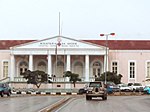National Assembly (Angola)

The National Assembly (Portuguese: Assembleia Nacional) is the legislative branch of the government of Angola. Angola is a unicameral country so the National Assembly is the only legislative chamber at the national level. The People's Movement for the Liberation of Angola (MPLA) has held a majority in the Assembly since Angolan independence in 1975. Multi-party elections were delayed under Jose Eduardo dos Santos quasi dictatorial rule for decades until the Angolan general election, 1992. The first Angolan legislative election was in September 2008. After a new constitution was adopted in 2010, the first election under this new constitution was held in 2012, increasing considerably the power of the President, and diminishing that of the National Assembly as well as that of the judiciary.
Excerpt from the Wikipedia article National Assembly (Angola) (License: CC BY-SA 3.0, Authors, Images).National Assembly (Angola)
Avenida do 1º Congresso do MPLA, Luanda Kinanga
Geographical coordinates (GPS) Address Nearby Places Show on map
Geographical coordinates (GPS)
| Latitude | Longitude |
|---|---|
| N -8.8194444444444 ° | E 13.228611111111 ° |
Address
Avenida do 1º Congresso do MPLA 29
Luanda, Kinanga
Luanda Province, Angola
Open on Google Maps








